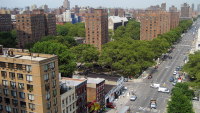Air Pollution and Asthma

Neighborhoods in New York City have greatly varying rates of asthma, with neighborhoods such as the Upper East Side having significantly fewer cases than in neighborhoods like Spanish Harlem and the South Bronx. Despite living in nearly adjacent neighborhoods, a child that grows up on the Upper East Side, is more likely to be affected by air pollution as a determinant of asthma compared to a child in Spanish Harlem, whose asthma is more likely to be aggravated by other factors. A recent study indicates that there might be more environmental contributors to childhood asthma than pollution exposure alone. Asthma prevalence differs greatly by neighborhood in New York City. Researchers have previously deemed certain neighborhoods “High Asthma Prevalence Neighborhoods” (HAPN) and “Low Asthma Prevalence Neighborhoods” (LAPN), based on the number of urgent medical visits for asthma symptoms, with asthma prevalence being the occurrence of the condition in a population. Higher asthma prevalence neighborhoods have a greater percentage of black and Hispanic families, while lower prevalence have a greater percentage of white families. Higher prevalence neighborhoods also have higher percentages of people living below the federal poverty level, people on public assistance and households with single mothers than the lower asthma neighborhoods.
The study, which examined 7 and 8 year olds was split into two groups: one group of the children were from lower asthma prevalence neighborhoods and the other was from higher asthma prevalence neighborhoods. To hopefully determine what contributes to some neighborhoods having higher asthma rates, the researchers used measurements of common air pollutants, including nitrogen dioxide (NO2), particulate matter (PM2.5), elemental carbon (EC), summer average ozone (O3), and winter average sulfur dioxide (SO2), and compared the concentration levels to asthma-related medical visits in the study population.
The researchers found that increased levels of these pollutants had a greater impact on the neighborhoods of lower asthma prevalence than those of higher asthma prevalence. The fact that the air pollution didn’t have as great an impact on the higher asthma prevalence neighborhoods indicates that there must be another factor at play, causing increased asthma in the higher prevalence neighborhoods. Some speculate that the higher rates of asthma could be due to social stressors, including parental and chronic childhood stress, as well as exposure to violence. Overall, seeing that air pollution increased asthma symptoms in certain neighborhoods, efforts to improve air quality should be targeted at urban neighborhoods with both high and low exposures to pollutants to attempt to address the disparity in asthma burden.
Lovinsky-Desir S, Acosta LM, Rundle AG, Miller RL, Goldstein IF, Jacobson JS, Chillrud SN, Perzanowski MS. Air pollution, urgent asthma medical visits and the modifying effect of neighborhood asthma prevalence. Pediatric Research. 2019 Jan;85(1):36–42. doi: 10.1038/s41390-018-0189-3.